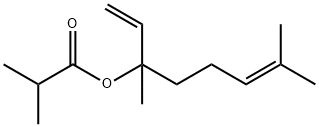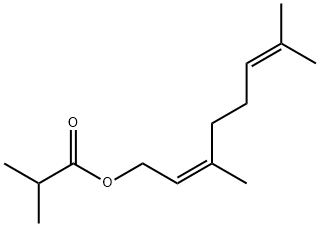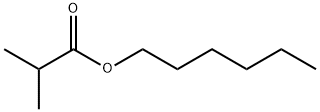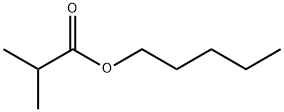LINALYL ISOBUTYRATE
- CAS NO.:78-35-3
- Empirical Formula: C14H24O2
- Molecular Weight: 224.34
- MDL number: MFCD00048312
- EINECS: 201-108-2
- SAFETY DATA SHEET (SDS)
- Update Date: 2024-12-23 19:56:12

What is LINALYL ISOBUTYRATE?
Description
Linalyl isobutyrate has a light, fruity odor with a lavender note and a sweet flavor reminiscent of black currant. May be synthe sized by esterification of linalool with isobutyric anhydride.
Chemical properties
Linalyl Isobutyrate has a fresh, fruity lavender odor,which is more refined than that of the butyrate. It is used in lavender compositions and in several floral notes.
Occurrence
Reported found in the essential oil of Ceylon cinnamon and in lavender oil; a dextrorotatory form has been reported in the oil from leaves of Agathosoma gnidioides and sour cherry.
The Uses of LINALYL ISOBUTYRATE
Linalyl Isobutyrate is a flavoring agent that is a liquid, slightly yellow in color with a fruity odor. it is miscible in alcohol, ether, and chloroform, and insoluble in water. it is obtained by chemical synthesis. it is also termed 3,7-dimethyl-2,6-octadien-3-yl isobutrate.
Preparation
By esterification of linalool with isobutyric anhydride.
Definition
ChEBI: Linalyl isobutyrate is a monoterpenoid.
What are the applications of Application
Linalyl Isobutyrate is used in perfume compositions, mainly in Lavender complexes, Bergamot bases, Lilac and Citrus-colognes, etc. The ester is also used in Banana, Blackcurrant, Cherry, Pear, Pineapple, Plum and other imitation fruit flavours, as well as in Nut, Spice, Citrus, Berry and various fruit complexes and bases. The concentration varies from 2 to 15 ppm in the finished product.
Taste threshold values
Taste characteristics at 20 ppm: floral, fruity, sweet, berry and citrus.
Toxicity evaluation
In the rat, the acute oral LD 50 was reported to be > 36.3 g/kg (Jenner, Hagan, Taylor, Cook & Fitzhugh, 1964). At this dose, the highest tested, toxic signs included depression, wet fur and diarrhoea, but the surviving animals appeared normal after 1 wk. In the mouse, the acute oral LD 50 was 151 g/kg (Jenner et al. 1964); animals were depressed soon after treatment and excitable after 1 hr, with rough fur, and death occurred between 4 hr and 3 days. The acute dermal LD 50 in rabbits was reported as > 5 g/kg (Moreno, 1974).
Properties of LINALYL ISOBUTYRATE
| Boiling point: | 305.75°C (rough estimate) |
| Density | 1.0013 (rough estimate) |
| vapor pressure | 3.5-6.1Pa at 20-25℃ |
| refractive index | 1.4576 (estimate) |
| FEMA | 2640 | LINALYL ISOBUTYRATE |
| Odor | at 100.00 %. light fruity lavender woody bergamot |
| JECFA Number | 362 |
| NIST Chemistry Reference | Linalyl isobutyrate(78-35-3) |
| EPA Substance Registry System | 3,7-Dimethyl-1,6-octadien-3-ol isobutyrate (78-35-3) |
Safety information for LINALYL ISOBUTYRATE
Computed Descriptors for LINALYL ISOBUTYRATE
New Products
Tert-butyl bis(2-chloroethyl)carbamate (S)-3-Aminobutanenitrile hydrochloride N-Boc-D-alaninol N-BOC-D/L-ALANINOL N-octanoyl benzotriazole 4-Hydrazinobenzoic acid 3,4-Dibenzyloxybenzaldehyde 1,1’-CARBONYLDIIMIDAZOLE R-2-BENZYLOXY PROPIONIC ACID 1,1’-CARBONYLDI (1,2-4 TRIAZOLE) 4-HYDROXY BENZYL ALCOHOL 3-NITRO-2-METHYL ANILINE (2-Hydroxyphenyl)acetonitrile 4-Bromopyrazole 5-BROMO-2CYANO PYRIDINE 5,6-Dimethoxyindanone 5-broMo-2-chloro-N-cyclopentylpyriMidin-4-aMine 4-methoxy-3,5-dinitropyridine 2-(Cyanocyclohexyl)acetic acid 2-aminopropyl benzoate hydrochloride 1-(4-(aminomethyl)benzyl)urea hydrochloride tert-butyl 4- (ureidomethyl)benzylcarbamate diethyl 2-(2-((tertbutoxycarbonyl)amino) ethyl)malonate Ethyl-2-chloro((4-methoxyphenyl)hydrazono)acetateRelated products of tetrahydrofuran








You may like
-
 873-83-6 6-Aminouracil (or) 4-Amino-2,6- dihydroxypyrimidine, (or) 6-Amino2,4-pyrimidinediol 99%View Details
873-83-6 6-Aminouracil (or) 4-Amino-2,6- dihydroxypyrimidine, (or) 6-Amino2,4-pyrimidinediol 99%View Details
873-83-6 -
 55441-95-7 99%View Details
55441-95-7 99%View Details
55441-95-7 -
 N-Vinylformamide 99%View Details
N-Vinylformamide 99%View Details
13162-05-5 -
 Chloro Uracil 1820-81-1 99%View Details
Chloro Uracil 1820-81-1 99%View Details
1820-81-1 -
 207557-35-5 99%View Details
207557-35-5 99%View Details
207557-35-5 -
 2-ethyl-6-methyl-3-hydroxypyridine succinate 99%View Details
2-ethyl-6-methyl-3-hydroxypyridine succinate 99%View Details
127464-43-1 -
 2-ETHYLPYRIDINE 100-71-0 99%View Details
2-ETHYLPYRIDINE 100-71-0 99%View Details
100-71-0 -
 181228-33-1 (S)-Methyl 3-amino-2-((tert-butoxycarbonyl)amino)propanote Hydrochloride (DAP-OMe. HCl) 99%View Details
181228-33-1 (S)-Methyl 3-amino-2-((tert-butoxycarbonyl)amino)propanote Hydrochloride (DAP-OMe. HCl) 99%View Details
181228-33-1